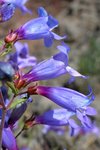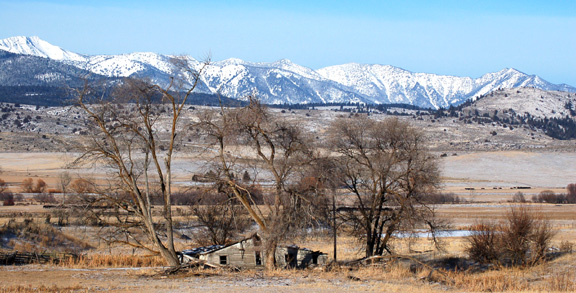Somewhere, I have a small framed pastel drawing of a springtime scene engulfing a quote by Henry David Thoreau: "I have an appointment with spring!" The quote is found in his journal from March 3, 1853. Here is an expanded and edited version:
"As soon as those spring mornings arrive in which the birds sing, I am sure to be an early riser, . . . . I have an appointment with spring. She comes to the window to wake me, and I go forth an hour or two earlier than usual. . . . When we wake indeed, with a double awakening--not only from our ordinary nocturnal slumbers, but from our diurnal--we burst through the thallus of our ordinary life, we wake with emphasis."
After those long, cold, too often cloudy and snowy days of winter in Baker County, it is an appointment that many of us, in the northern latitudes the world over, are all to eager to keep--and none more so than myself. Despite whatever the calendar may say, the arrival of spring never seems so certain as that, but then to me, spring has never truly arrived until the buds of the buttercup burst open in the sagebrush, when the neighborhood yards begin to sparkle with the color of crocus, and when a few long, warm sunny days urge me to emerge from my shameless winter lethargy so as to begin curious adventures in our beautiful but besieged natural world. This year, after a few false starts, spring arrived, for me at least, with a celebratory bang on the last day of March and the first day of April.
I took advantage of those startlingly warm and sunny days to explore for early spring things and revel a bit in the beauty of Baker County. Here are a few of the things I found those two days.
Riding east on Highway 86 just after passing the Oregon Trail Interpretive Center and shooting range, a pair of sometimes elusive Sage Thrashers (Oreoscoptes montanus) dropped down off the barbed wire fence on the north side and scurried into the deeper sagebrush. Before reaching the top of the hill, I found another singing on a fence post and stopped to photograph it. He didn't let me get close enough for a terrific photo, but here is a Sage Trasher singing along that highway from April of last year.
 Sage Thrasher
Sage ThrasherBecause these excellent singers spend a lot of the time scratching out a living on the ground searching for insects, they are described as elusive, and more often heard than seen. They are actually not very difficult to find though in some of the healthier big sagebrush stands along the highway from before the Interpretive Center and on east past Ruckles Creek Road in the spring (more of a challenge thereafter). After spending the winter from se. California to Texas and portions of Mexico, they return to Baker County in late March and early April.
Another little treasure harbored by the sagebrush is one of our earliest spring wildflowers--the modestly sized but dazzlingly cheerful and hard to miss Sagebrush Buttercup (Ranunculus glaberrimus).
 Sagebrush Buttercup
Sagebrush ButtercupAs it does well in somewhat disturbed or early seral communities it can be found amongst the grazed sagebrush and weeds on the BLM managed Goose Creek grazing allotment (the dogs and I hiked the dirt road west from the Sparta Road), and on up through the healthier but well grazed sagebrush areas east of Sparta. A walk along Seismograph road and some of the spur trails (or east Sparta Rd. on the ridge) will provide viewing for a few interesting plant communities, especially eroded rocky scabland areas. Most buttercups are slightly to very toxic to many mammals, but less toxic young Sagebrush Buttercup plants are used to varying degrees by wildlife and sometimes by stock animals.
 Sagebrush Buttercup
Sagebrush ButtercupAnother very early wildflower that some might miss, is the unassuming little Gorman's Biscuitroot (Lomatium gormanii). It is also called "salt & pepper."
 Gorman's Biscuitroot
Gorman's BiscuitrootI find them on rocky ridge tops, scablands and nearby well drained hillsides in Grant and Baker Counties. Although always found east of the Cascade's, they range north into Washington, further south in Oregon and east into Idaho. It is blooming now in areas near Seismograph Road east of Sparta.
The starchy roots of some Lomatiums were utilized as a food source by Native Americans.They were cooked and eaten or ground into a type of flour and used to make biscuits and cakes. Lomatium gormanii has a deeply buried, large round radish-like root that one report lists as being used by the Nez Perce Tribe.
I also found one lonely clump of Lanceleaf Springbeauty (Claytonia lanceolata) near Seismograph Road east of Sparta.
 Springbeauty
SpringbeautyA widely distributed species in the West, they too are among the very earliest spring flowers, emerging soon after snowmelt. I normally see them much higher in the mountains. The root, a globose corm, is said to be quite tasty, although it is much better to leave them to brighten the next year's spring (unless you happen to be actually starving).
 Springbeauty, Santa Rosa Range, Humboldt County, NV, June 7, 1996
Springbeauty, Santa Rosa Range, Humboldt County, NV, June 7, 1996Mountain Bluebirds and Violet GreenSwallows in Sparta
 Sparta Butte, April 1, 2011 (Migratory birds make a living here in early spring despite the snow)
Sparta Butte, April 1, 2011 (Migratory birds make a living here in early spring despite the snow)There are many beautiful birds in the world, and a few of them live and breed right here in Baker County. One of my favorites for irresistible eye-pleasing beauty, and the best that blue has to offer, is the mountain bluebird (Sialia currucoides).
 Mountain Bluebird, "Downtown" Sparta, 4/1/11
Mountain Bluebird, "Downtown" Sparta, 4/1/11This insect eater nests throughout much of Oregon from slightly west of the Cascades to most of eastern Oregon, where it is more common. "Birds of Oregon" (Marshall, Hunter, & Contreras, OSU Press, 2003-2006), states that "important factors determining habitat selection are availability of suitable nesting cavities and open terrain (Farner, 1952)." With some shame (Hey, forgive me, I grew up in the chaparral of S. California!), I learned part of this first hand when I cut down a slightly burned dead Aspen in a "free" (is anything really free?) firewood area on the Fishlake National Forest about 25 years ago, only to find that it contained an active nesting cavity with four young mountain bluebirds at fledgling stage. A more favorable experience was watching these gorgeous birds fly from a perch high in a conifer to just a yard or so in front of me at 10,000 feet in the Pahvant Range of Utah, in order to pick up young grasshoppers in a clearing. Aside from ignorant humans (as in cutting down their nesting trees), a major threat to the species in lower elevation areas near human habitation are the alien and highly competitive European starlings and house sparrows, which also use up available tree cavities or bird boxes. Heavy grazing and fire suppression also takes a toll on the Aspen patches that are often used for nesting. Fortunately, it breeds over a wide area of the American West in cavities from sagebrush-(older) Juniper communities to near timberline and readily accepts bird boxes put up for its use outside of towns and cities.
The two birds below were refurbishing this nest box on Sparta Lane on April 1st.
 Mountain Bluebird, female on nest box, Sparta, Oregon
Mountain Bluebird, female on nest box, Sparta, Oregon Mountain Bluebird, male on nest box, Sparta, Oregon
Mountain Bluebird, male on nest box, Sparta, OregonAnother migratory bird, the Violet-green Swallow (Tachycineta thalassina) has also returned to Sparta, despite the largely snow-covered ground. Flying insects are be at a premium, but they must know what they are doing. I have identification photos from Sparta on April 1, 2011, but here is a better, closer one.
 Violet-green Swallow at nest box, ne. of Elgin, June 15, 2007
Violet-green Swallow at nest box, ne. of Elgin, June 15, 2007The "Birds of Oregon" reference mentioned previously states that "Unlike the Tree Swallow it commonly nests in niches and cavities on urban buildings and readily uses nesting boxes in residential areas. Its soft twittery call notes are a familiar pre-dawn sound as they fly about overhead. A very early spring migrant concentrating about streams and wetlands where emerging insects can be found until warmer weather allows them to move into more upland areas."
Waterfowl in the area.
Migratory waterfowl, moving through to more northern latitudes, are also still abundant in the Baker City area.
A true harbinger of spring as far as timing is concerned, is the Canvasback (Aythya valisineria).
 Canvasback, Kearney-USFWS photo
Canvasback, Kearney-USFWS photoA dozen or so seem to regularly appear about the time of the (spring) vernal equinox on the middle pond along the Best Frontage Road at the edge of Baker City, where they were last week. These have been the premier table duck of culinary connoisseurs in the past (and present), but the taste is said to depend on just what these ducks have been feeding on. Their table status among hunters, i.e., the "gold standard" (Birds of Oregon), aka "Lordly Canvasback" ("The Book of Birds," National Geographic 1939), reputation and habitat shrinkage have taken a large toll on populations though, and the Canvasback populations still appear to be declining or perhaps stable in Oregon. They are easily confused with the Redhead (Aythya americana), another not-so-common Baker County migrant. The head slopes into the bill and is not so red as in the Redhead, whose head is more abruptly round, and their "canvas" back is much whiter. Below is a Redhead for comparison.
 Redhead, Tule Lake, Ladd Marsh, May 1, 2008
Redhead, Tule Lake, Ladd Marsh, May 1, 2008Other spring favorites.
The diving Common Goldeneye (Bucephala clangula) is now common in local ponds and especially in the lower Powder River canyon, with courtship displays easily observed. They also congregate along the Snake River prior to spring. Their clear nictitating membrane allows them to see very well underwater in their dives for food--a clear advantage in that environment, especially in the often muddy water of the Powder River in springtime. Their diet consists mainly of small aquatic animal life, but they do partake of plants. They nest in trees near high elevation lakes.
 Common Goldeneye on a cloudy spring day in the Powder River.
Common Goldeneye on a cloudy spring day in the Powder River. The Bufflehead (Glaucionetta albeola), aka "butterball" or "buffalo-head," is also fairly common now on local ponds, although they are probably leaving soon for breeding areas in Canada and Alaska.
 Buffle heads, Female left, Male on right, on Best Frontage Road-UPS Pond #2, March 22, 2011.
Buffle heads, Female left, Male on right, on Best Frontage Road-UPS Pond #2, March 22, 2011.Birds of Oregon (reference) states that "The Bufflehead is N. America's smallest diving duck, giving it the advantage of being able to nest in abandoned holes of Northern Flickers, a plentiful resource off-limits to larger cavity-nesting ducks." They feed on aquatic insects and their larvae, but also other small aquatic animals, as well as seeds and other aquatic plant material. It also nests in trees or nest boxes near water at high elevation lakes.
Lastly for now, another spring-time migrant that has been here for several weeks, and is also leaving, is the Ring-necked Duck (Aythya collaris). These fast flyers have been common on the Best Frontage Road ponds, and the often overlooked pond along S. Airport Road at the Britt Sand and Gravel plant in the last month (along with others, including Common Mergansers).
People most often think that "Ring-bill" would be more appropriate due to the fact that the ring around the neck is rarely seen, while the ring around the bill always is. I found the duck in the following photo, which shows the ringed neck, on the dredge ponds above Phillips Reservoir back on June 12, 2008. As noted in "Birds of Oregon" reference, the Ring-necked duck may be confused with the scaups. But as they say "The black back, white crescent on the side just in front of the wing, and white-ringed bill separate the drake male ring-neck from the scaups."
 Ring-necked Duck on dredge pond above Phillips Reservoir.
Ring-necked Duck on dredge pond above Phillips Reservoir.Ring-necks are uncommon breeders in Oregon, favoring boreal forests of upper Canada and se Alaska. They are more vegetarian feeders than others in the genus. They nest on floating or emergent vegetation or on islands close to water (previously cited "Birds of Oregon" reference).
__

Decorah, Iowa, Eagle Cam
Provided by Cathy Nowak, Fish & Wildlife Biologist and more, at the ODFW Ladd Marsh Wildlife Area in Union County. Click on Decorah Eagles link:
Decorah Eagles
Total views: 11,167,542
First hatch 4/2/11. 24-hour collage of first egg pip and hatch Second hatch 4/3/2011. First glimpse of second hatchling Third hatch expected in a couple of days. The Raptor Resource Project brings you the Decorah Eagles from atop their tree at the fish hatchery in Decorah, Iowa.

__
Bird Meeting in Baker City
From Joanne Britton:
There will be a meeting at the library at 9:30 AM April 9th to recruit birders, talk about where to find birds and IDing them, getting people involved in various counts, and doing a little walk along the river to look for birds. We will also plan other little trips around Baker to bird and practice skills. This will be very informal. Bring your binoculars and pass the word.
__
Enough for now.
Blog will return to backlog on Obama's War on Libya, and other harsh realities, soon enough, but I hope this one has been a pleasant break.












2 comments:
Chris,
Great photos and information.
Thanks,
Ken
Hey Ken, Thank you! It means a lot to me that someone appreciates the post.
Chris
Post a Comment